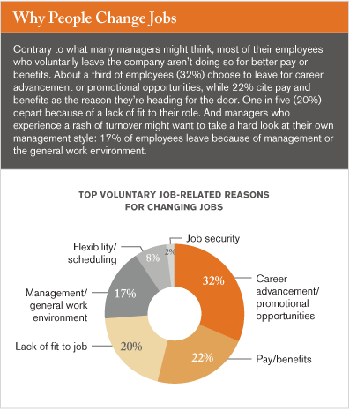 Workforce managers, human resources professionals as well as industrial psychologists all have their own theories on the question of – “What are the reasons for employee turnover”.
Workforce managers, human resources professionals as well as industrial psychologists all have their own theories on the question of – “What are the reasons for employee turnover”.
Among the most common causes of employees leaving a company are:
= >> Excessive workload, an employee doing the work of more than one person. This often entails overtime and necessitating the employee having to take work home. Many employees say that they become overwhelmed and overloaded with work. The increase in stress levels and pressure means that they cannot sustain it and will eventually seek employment elsewhere.
= >> Management not giving the employee sufficient recognition for the work done, or taking the credit themselves of giving it to the wrong person.
= >> Not giving the staff member sufficient power to make decisions to get the job done and to progress in the organization.
= >> Ongoing change initiatives giving the employee a sense of instability.
= >> Management not giving clear briefs and clear guidelines on their expectations of the employee.
= >> Poor leadership skills
We’ve broken down the “Terrible Ten” employee turnover rate drivers to help you diagnose your business’ employee retention plan.
= >> Poor leadership. Can you do much about this one? Absolutely. It’s far more prevalent than most imagine, and it has an astounding impact on employee turnover rates and costs.
= >> Salary. 20% of workers cite this as their top employee retention consideration.
= >> Employee benefits packages. Another 20% claim this as their most important employee retention consideration. = >> Far more than salary, an effective employee benefits plan can generate an exceptionally high ROI as an employee retention strategy.
= >> Lack of education opportunities. Employees’ top request was for professional education and enhancement programs. Another name for stagnant employees: job seekers!
= >> Poor wellness offerings. If your staff doesn’t like your employee health and wellness programs, they are four times more likely to leave your company.
= >> Toxic workplace environment. This is due in part to poor leadership, but interpersonal stress at the workplace contributes to absenteeism and low employee motivation, and ultimately, high employee turnover rates.
= >> Lack of progression opportunity. If your employees see no hope for promotion, they will absolutely look elsewhere for employment. So if the idiot son-in-law is a permanent fixture in the corner office, beware!
= >> Personal reasons. There’s not much you can do about this one. Just like the toymaker elf who wanted to be a dentist, if an employee’s life ambition takes them in a different direction, your best bet is to let them go.
= >> Lack of FUN. The best jobs I’ve ever had have been fun. Not surprisingly, they’ve also been the jobs at which I’ve worked the hardest and produced the most. The same holds true for your employees. Do everything possible to add fun back into life at work.
= >> Lack of life balance. Give your employees time away. Make sure they take it. And give them a vehicle to take high-end destination vacations at low cost. The mental and physical health benefits of wellness travel are staggering, and the impact on retention is powerful.
Many U.S. employers recognize 10 federal holidays, if not more.
Organizations commonly provide nine or ten days per year as public holidays, although there is no standard. Federal holidays, or legal public holidays, are recognized by Congress but are not observed by all employers.
Legal public holidays:
= >> New Year’s Day, January 1
= >> Martin Luther King, Jr. Day, the third Monday in January
= >> Washington’s Birthday, the third Monday in February
= >> Memorial Day, the last Monday in May
= >> Independence Day, July 4
= >> Labor Day, the first Monday in September
= >> Columbus Day, the second Monday in October
= >> Veterans Day, November 11
= >> Thanksgiving Day, the fourth Thursday in November
= >> Christmas Day, December 25

 Follow
Follow